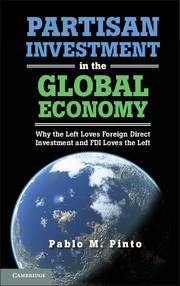 Partisan Investment in the Global Economy
Partisan Investment in the Global Economy Book contents
- Frontmatter
- Contents
- List of Figures
- List of Tables
- Acknowledgments
- 1 Domestic Coalitions and the Political Economy of Foreign Direct Investment
- 2 A Political Economy Model of Foreign Direct Investment
- 3 Tying Hands or Exchanging Hostages: Partisan Governments, Commitment, and FDI Performance
- 4 Partisan Governments and Foreign Direct Investment: Results from Cross-Country Statistical Analyses
- 5 Labor and Business Influence, Investment Regimes, and Foreign Investment in Argentina
- 6 Business Influence, Politics, and Foreign Direct Investment in South Korea
- 7 Conclusion
- Bibliography
- Index
2 - A Political Economy Model of Foreign Direct Investment
Published online by Cambridge University Press: 05 March 2013
- Frontmatter
- Contents
- List of Figures
- List of Tables
- Acknowledgments
- 1 Domestic Coalitions and the Political Economy of Foreign Direct Investment
- 2 A Political Economy Model of Foreign Direct Investment
- 3 Tying Hands or Exchanging Hostages: Partisan Governments, Commitment, and FDI Performance
- 4 Partisan Governments and Foreign Direct Investment: Results from Cross-Country Statistical Analyses
- 5 Labor and Business Influence, Investment Regimes, and Foreign Investment in Argentina
- 6 Business Influence, Politics, and Foreign Direct Investment in South Korea
- 7 Conclusion
- Bibliography
- Index
Summary
Introduction
As discussed in Chapter 1, foreign direct investment (FDI) flows have become an important part of total investment flows, and now play a major role in growth and development. National and local governments across the planet have adopted various types of policies to attract or deter inward FDI. Allegedly, developed countries have converged on less discriminatory regimes toward foreign investors. A tally of the number of changes in foreign investment regulation seems to underscore this trend (Table 1.2). However, Table 1.2 also shows that the number of restrictive measures have increased dramatically since 2001, probably as a response to the global recessions of 2001 and 2008, and regional crises inmost corners of the world. There is also great variance in the orientation of investment regimes across countries and over time, even among OECD countries. In recent years, discontent toward foreign investors has become rampant not only in crisis-stricken countries, but is expressed in a rhetoric that resonates with the the policy debates of the 1970s. In this chapter, I present a formal derivation of the logic behind the partisan theory of foreign investment, which aims at explaining the observed variance in regulatory regimes toward foreign investment and the positive association between left-leaning governments and direct investment flows.1Given that the conditions for investment are present, domestic politics is likely to play a major role in shaping how foreign investment is regulated, or how open countries are to FDI.
- Type
- Chapter
- Information
- Partisan Investment in the Global EconomyWhy the Left Loves Foreign Direct Investment and FDI Loves the Left, pp. 42 - 70Publisher: Cambridge University PressPrint publication year: 2013


